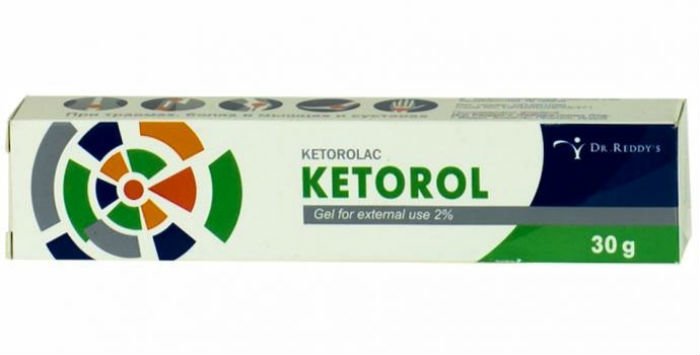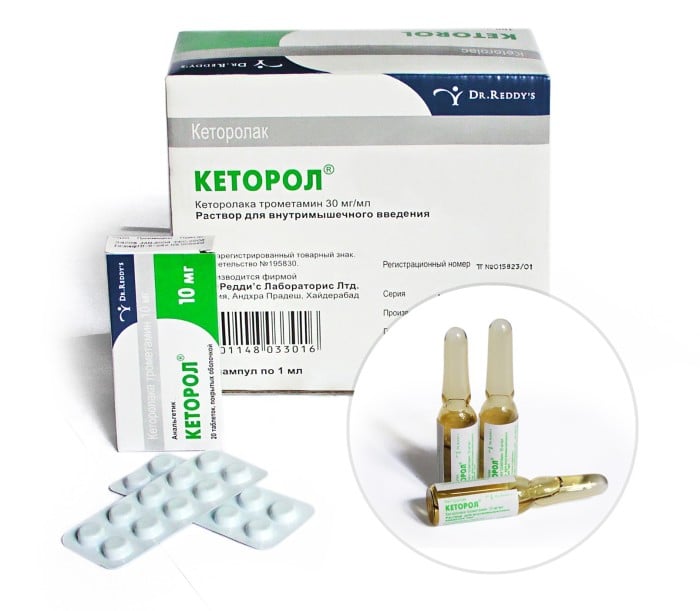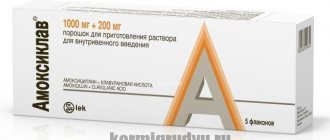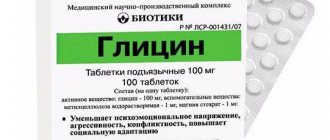Contraindications and side effects
Ketorol is a non-steroidal anti-inflammatory drug with a pronounced analgesic effect.
The main active ingredient is ketorolac. This powerful non-narcotic remedy not only relieves pain, but also relieves inflammation and reduces high fever. The injection takes effect after half an hour, and the tablets after 60 minutes. The drug is used during breastfeeding in the following cases:
- Elimination of pain of any origin
- Postoperative recovery
- Oncological diseases that are accompanied by pain.
The analgesic effect of the drug is so strong that it is often compared to morphine. The question of prescribing Ketorol is decided by the doctor; the medication is not dispensed without a prescription.
According to the instructions, the drug has many contraindications and is prohibited for use during pregnancy and breastfeeding. And all because the active components that penetrate into mother’s milk negatively affect the child’s body.
- Aspirin-induced bronchial asthma
- Bronchospastic syndrome
- Quincke's edema
- Decreased total blood volume
- Dehydration of body tissues
- Erosion and ulcers of the gastrointestinal tract
- Low blood clotting
- Impaired liver or kidney function
- Brain hemorrhage
- Combination with other non-steroidal anti-inflammatory drugs
- Pregnancy and lactation
- Children under 16 years old
- Hypersensitivity to the components of the drug.
Lactation is a crucial period during which a young mother should remain calm, peaceful and, of course, healthy. But sometimes, a sudden onset of pain unsettles you, interferes with your maternal responsibilities and simply ruins your mood.
How to relieve pain during lactation without harming the baby? This will be discussed further.
Ketorol is an excellent analgesic that is widely used in everyday life to reduce pain of various origins. But when it comes to pain during lactation, then it’s worth thinking about.
After all, now a woman is responsible not only for herself, but also for the health of her developing baby. Is it possible to use Ketorol during breastfeeding without harming the baby? Almost every breastfeeding woman asks this question.
Ketorol belongs to the group of non-steroidal drugs that have anti-inflammatory, analgesic and antipyretic effects on the patient’s body.
This medication is especially known as an effective analgesic, while the anti-inflammatory and antipyretic effects are not so pronounced.
The main active component of the drug is ketorolac, a non-narcotic drug that does not cause addiction and dulls the production of prostaglandins that provoke pain.
Ketorol is available in three dosage forms, which differ in the method of introducing the drug into the body and the amount of the active substance in it. Regardless of the concentration of ketorolac in the composition of the medication, Ketorol is a very strong drug and is available only with a doctor's prescription.
Forms of release of Ketorol:
- tablets for oral administration (ketorolac content - 0.01 grams);
- gel for external use (ketorolac content - 0.02 grams);
- injection solution for intramuscular administration (ketorolac content - 0.03 grams).
The highest level of concentration of the active substance is in injections for intramuscular administration. Ketorol Gel is used for external use and is available by prescription. Ketorol tablets are biconvex in shape and covered with a green film coating.
In terms of the strength and nature of the analgesic effect, Ketorol is often compared with morphine. Moreover, Ketorol is a symptomatic drug that only eliminates the symptoms of the disease, but does not fight its source.
According to the instructions, the use of the drug Ketorol during breastfeeding is contraindicated. But some experts still prescribe this medication to nursing mothers in cases where the expected benefits of its use are much higher than the possible side effects for both mother and baby. A doctor may prescribe treatment with Ketorol in the following cases:
- toothache;
- pain after injury, dislocation and sprain;
- pain in the postpartum period and after cesarean section;
- neuralgia and radiculitis;
- rheumatism and arthritis;
- pain due to cancer;
- myalgia - muscle pain.
I believe that not all types of pain need to be treated with medications. For example, when my baby suckled at the breast, my toothache and menstrual pain went away. From medical sources, I learned that this is due to the fact that during the latching of a child, the amount of certain hormones increases and the woman’s condition improves.
Despite the fact that Ketorol is contraindicated during lactation, some experts prescribe it to nursing mothers and do not see any harm to the health of a developing baby from a single dose of the medicine. Moreover, according to the electronic Spanish medical directory E-lactacia, this medication is compatible with breastfeeding.
The tablets contain the lowest concentration of the active ingredient ketorolac. According to the instructions, you need to take no more than 4 tablets per day. But no doctor will prescribe such a dose to a young mother. Usually a one-time dose of the drug is prescribed.
The maximum concentration of the substance in a woman’s body is reached one hour after taking the medicine. Before taking Ketorol, a woman needs to express breast milk and temporarily stop lactation.
You can start putting your baby to the breast at least 6 hours after using the medicine.
Ketorol tablets are available only with a doctor's prescription. And their independent use, even one-time use, by a nursing mother is unacceptable.
Ketorol injection solution has the highest concentration of active substance in its composition.
Very often, young mothers after a caesarean section are given the drug Ketorol intramuscularly for three days to dull the pain after the operation.
Since women after a cesarean section begin producing milk a little later than those who give birth naturally, the negative impact of the medication on the baby’s body is minimized.
For medical reasons, pain relief with medications after a cesarean section is carried out for three days. After this, at the next round, the doctor asks the woman in labor about the need to extend the pain relief injections. This is especially true for women who, for objective reasons, cannot breastfeed their child.
Ketorol gel is used externally, but nevertheless its active ingredients penetrate into the blood of a nursing woman, and therefore into the body of a developing baby along with milk. A gel is prescribed to relieve pain from dislocations, bruises and sprains. Apply a thin layer to the skin, usually 3-4 times a day.
DETAILS: Teeth restoration pin time
Thus, the use of all dosage forms of the drug must be strictly controlled by a doctor and lactation must be stopped during the period of its use.
Ketorol has a huge number of contraindications. Its use is prohibited in the following cases:
- pregnancy and lactation;
- children under 16 years of age;
- renal and liver failure;
- bronchial asthma;
- individual intolerance to the components of the drug;
- peptic ulcer, inflammatory processes and internal bleeding in the gastrointestinal tract;
- lactose deficiency and intolerance;
- the presence of polyps on the mucous membranes of the nose and paranasal sinuses;
- hemophilia and poor blood clotting;
- heart failure and other cardiovascular diseases;
- high level of potassium in the blood.
Benign formations in the sinuses are a contraindication to the use of Ketorol
The use of the drug should occur under the strict supervision of a physician, since Ketorol can cause various complications and side effects, even after a single use.
Side effects from taking Ketorol appear in cases of drug overdose or in case of individual intolerance to the components of the medication.
At the first symptoms of an overdose or allergic reaction, you must immediately stop taking the drug and seek advice from a physician.

In case of allergic swelling of the larynx and difficulty breathing, you must immediately take an antihistamine tablet: Zodak, Suprastin, Fenkarol. Then you should call an ambulance.
In my home medicine cabinet, Fenkarol tablets are a must-have medicine. Even though neither I nor the child are allergic. This medication is approved for use during lactation. Very often I use a quarter of a Fenkarol tablet and a half of No-shpa to relieve pulmonary spasms with an incessant cough in a three-year-old child.
The effect of the medication on the body of a nursing woman has not been fully studied, which means there may be many more side effects.
Ketorol, entering the baby’s blood along with breast milk, poisons the child’s body, since metabolic processes have not yet been fully established in it, which means the active substances of the drug are not removed from the soft tissues, but simply accumulate in them. Thoughtless use of the drug by a nursing woman can cause the following pathologies in a child:
- liver dysfunction;
- damage to the functions of the central nervous system;
- hematopoietic disorder.
Most breastfeeding women are wary of using Ketorol during breastfeeding. Most of them are frightened by the huge number of contraindications and side effects.
Therefore, young mothers try to fight pain using alternative medicine methods or choose less dangerous medications: No-shpu, Ibuklin.
Doctors, in turn, allow the medication to be taken during lactation.
Ketorol is a very strong drug that is only available with a doctor's prescription. And its one-time use is permissible only after consultation with a specialist, if the expected benefits from its use are much higher than the possible risks.
Ketorol as a medicine
Ketorol belongs to the group of non-steroidal drugs that have anti-inflammatory, analgesic and antipyretic effects on the patient’s body. This medication is especially known as an effective analgesic, while the anti-inflammatory and antipyretic effects are not so pronounced. The main active component of the drug is ketorolac, a non-narcotic drug that does not cause addiction and dulls the production of prostaglandins that provoke pain.
Forms of release of Ketorol
Ketorol is available in three dosage forms, which differ in the method of introducing the drug into the body and the amount of the active substance in it. Regardless of the concentration of ketorolac in the composition of the medication, Ketorol is a very strong drug and is available only with a doctor's prescription.
Forms of release of Ketorol:
- tablets for oral administration (ketorolac content - 0.01 grams);
- gel for external use (ketorolac content - 0.02 grams);
- injection solution for intramuscular administration (ketorolac content - 0.03 grams).
Photo gallery: dosage forms of Ketorol
In terms of the strength and nature of the analgesic effect, Ketorol is often compared with morphine. Moreover, Ketorol is a symptomatic drug that only eliminates the symptoms of the disease, but does not fight its source.
Can I take the drug while breastfeeding?
The main active substance is ketorolac. It has an anti-inflammatory effect and quickly neutralizes pain. Is it possible to take the painkiller Ketorol while breastfeeding or mixed feeding? This is allowed, but only after examination by a doctor.
The drug is non-steroidal, which is important for the body of children in the first year of life. The medicine is not addictive. Women with breastfeeding should remember: almost all chemicals from their body freely penetrate into breast milk. Ketorol is contraindicated in this category of women, but is permitted at the discretion of the doctor. It should be taken with great caution (minimum dose and only in extreme cases).
Composition of the drug
There are 3 dosage forms of the drug.
1. Ketorol gel, which has the following composition:
- ketorolac – 0.02 g;
- propylene glycol;
- dimethyl sulfoxide;
- acrylate copolymer;
- E218;
- thromitamine;
- water;
- food additive "Drymon Inde";
- ethanol;
- glycerol.
2. Tablets, components:
- ketorolac – 0.01 g;
- microscopic cellulose;
- milk sugar;
- corn starch;
- pyrogenic silicon dioxide;
- stearic acid;
- sodium starch glycolate;
- methyloxypropylcellulose;
- propylene glycol.
3. Liquid for injections consists of the following components:
- ketorolac – 0.03 g;
- sodium chloride;
- ethanol;
- disodium salt of ethylenediaminetetraacetic acid;
- octoxynol;
- propylene glycol;
- caustic soda;
- distilled water.
The highest level of ketorolac is in the liquid form of the drug, and therefore the solution is not recommended for use during lactation.
Ketorol during breastfeeding - can a nursing mother take it?
According to the instructions, Ketorol is prohibited from being taken by pregnant and lactating women. However, in some cases you cannot do without the drug. Therapists warn that this remedy should be used with caution when breastfeeding. After all, components that penetrate a child’s body disrupt the functioning of the liver, central nervous system, and hematopoietic system.
A nursing mother can take 1 tablet of Ketorol for severe pain, but only after the doctor's approval. This means a dose of 0.01 g of the drug, but even this is enough to disrupt the functioning of the baby’s body.
If the pain syndrome has not disappeared, a consultation with your doctor is necessary, as a repeat appointment is not permissible! The following side effects are possible:
- suppression of lactation;
- the components of the drug poison the child’s body;
- the liver and central nervous system are affected;
- jaundice.
These are not all the consequences of taking Ketorol. The drug has not yet been fully studied, and therefore the full list of side effects is not known. A single dose of painkiller is recommended.
Not all types of pain need to be treated with pain medications. For example, toothache or menstrual pain subsides while the baby is breastfeeding. This is explained by the fact that at this moment the level of hormones in the blood increases, and the mother’s condition improves.
If the doctor has approved the use of Ketorol, then it is necessary to express milk in advance or temporarily transfer the baby to artificial nutrition. It is necessary to skip 3 feedings until the medication is cleared from the mother’s body.
When breastfeeding, a woman must take full responsibility not only for nutrition, but also for her health. In this case, the baby will be guaranteed to grow and develop well.
DETAILS: Correction of bite with braces in Moscow, how much do braces cost in Moscow
However, acute pain can occur at any moment, which not only spoils the mood, but also prevents you from doing normal work caring for the baby and at home. To eliminate it, it is allowed to use only absolutely safe drugs. Their composition should not cause harm.
That is why every mother may have a question, is it possible to use Ketorol while breastfeeding?
Indications
Ketorol is a drug that is recommended to be used to eliminate the inflammatory process. It does not contain steroids, which can negatively affect the baby’s health. The main active ingredient is ketorolac.

It does not have a narcotic effect, but is able to eliminate severe pain and spasms within a short time. Thanks to this ingredient, it is possible to relieve inflammation and lower body temperature. A woman can feel the positive effects within an hour after taking it.
In some cases, relief comes much faster.
Ketorol is recommended for use to eliminate the following pathologies:
- severe pain, the nature of which has not been fully established;
- rehabilitation of the patient in the postoperative period;
- improving the general well-being of patients with cancer.
Additionally, it should be noted that the drug has a strong analgesic effect. Some doctors believe that the effect of the drug is similar to morphine. The doctor decides whether it is appropriate for breastfeeding mothers. The drug is not available without a prescription.
Tablets during breastfeeding can only be taken as prescribed by a doctor.
The instructions contain many side effects and contraindications. It also contains information that the drug should not be taken during pregnancy and lactation. The composition contains quite active components that negatively affect the composition of milk and the general condition of the child’s body.
Today, there are three dosage forms of the drug that are used as therapy by different patients. Their composition differs in several effective components. The choice of form depends on them:
- gel;
- pills;
- liquid that is used for injection.
Can Ketorol be used during pregnancy and lactation? The instructions contain information that this process is not permissible. However, there are cases when it is impossible to do without this drug during hepatitis B.
During this period, the medicine can only be used with extreme caution. The components penetrate into the milk and can negatively affect its composition.
They interfere with the normal functioning of the liver, central nervous system and blood flow.
When a person experiences pain, he takes painkillers. And if it is usually not so difficult to choose the right medicine, then during breastfeeding most drugs are prohibited. Ketorol is an effective analgesic. But can a nursing woman have it?
Ketorol is an effective pain reliever. This drug is not available without a doctor's prescription as it is a strong medicine.
Ketorol is an effective remedy for acute pain
Ketorol is commercially available in the form of tablets, gel, and solution for injection. The main active ingredient of this drug is ketorolac.
Ketorol injection solution contains the highest concentration of ketorolac. The effect of Ketorol gel is local. In the form of tablets, Ketorol is very convenient to take with you on the road.
The most pronounced effect of Ketorol is pain relief. The anti-inflammatory and antipyretic properties of this drug are weakly expressed. These qualities are much better manifested in Paracetamol. Ibuprofen (Nurofen, MIG) or safe antispasmodics - No-shpa or Drotaverine - will help a nursing mother relieve a headache, toothache or, for example, pain in the lower abdomen.
Indications for the use of Ketorol, indicated in the instructions, are various pains:
- injuries;
- toothache;
- pain in the postpartum and postoperative period;
- pain due to cancer;
- myalgia;
- arthralgia;
- neuralgia, radiculitis;
- pain with dislocations, sprains;
- rheumatic pains.
Very often in maternity hospitals, Ketorol is used as an anesthetic drug. It helps to quickly and effectively relieve pain in women who have given birth through surgery. As a rule, milk comes to such mothers a little later, and therefore the risk of side effects from the baby in the first days after surgery is minimized.
The official instructions indicate that Ketorol is used in the form of tablets in quantities of no more than 4 pieces per day for no longer than 5 days in a row.
Of course, this is the maximum allowable amount, and it is unlikely that a doctor will prescribe it to a nursing mother. The instructions also indicate a ban on using the drug while breastfeeding.
However, many pediatricians believe that a single use of the drug by a nursing woman will not harm the baby.
According to the authoritative reference book of the Spanish hospital Marina Alta E-lactancia, Ketorolac is compatible with breastfeeding. Its penetration into breast milk is not sufficient to cause harm to the baby from a single dose. But you need to remember that any medications during breastfeeding can only be used after consulting a doctor.
In gel form, Ketorol is used topically for injuries, bruises, and sprains. The product is applied to cleansed, dry skin in a thin layer. You can lubricate the affected areas no more than 3-4 times a day.
The minimum time between applications is 4 hours. The gel can be used for no more than 10 days.
It must be remembered that ketorolac, even in the gel, penetrates into breast milk, so after using the gel it is recommended to refrain from feeding for 2-4 hours.
Important! It is better to express milk before using the drug in case the baby requires breastfeeding earlier than the specified period.
Side effects
Side effects may include allergic reactions. And quite serious, up to swelling of the larynx and difficulty breathing. Impaired functioning of the kidneys and urinary system may occur.
From the gastrointestinal tract there may be diarrhea, nausea, vomiting, constipation. It is extremely rare that more serious disorders may occur: stomach and intestinal ulcers, internal bleeding, jaundice, hepatitis.
Ketorol can cause headache, drowsiness, and dizziness. Very rarely, more serious disorders can be observed: hallucinations, deterioration of vision and hearing, anxiety, meningitis, convulsions, mental instability.
DETAILS: How long does it take to clean your teeth at the dentist?
If any side effects occur, you should stop taking the drug and consult a doctor. If swelling of the larynx occurs and difficulty breathing occurs, you must immediately take an antiallergic drug (Zodak, Suprastin, Loratadine) and call an ambulance.
Contraindications

Contraindications for the use of Ketorol include:
- Bronchial asthma.
- Polyposis of the nose or paranasal sinuses.
- Ulcers and erosions of the stomach.
- Active gastric bleeding.
- Intestinal inflammation in the acute phase.
- Liver failure or any other liver disease.
- Kidney failure.
- Poor blood clotting, hemophilia.
- Hyperkalemia.
- Lactose deficiency, lactose intolerance.
- Heart failure.
- Intolerance to ketorolac.
Ketorol very effectively and quickly allows you to cope with pain of various origins. Its one-time use as a painkiller is acceptable during breastfeeding, but if possible, it is better to use other, safer medications. For example, you can fight a fever with Paracetamol, and a headache or toothache with Ibuprofen.
Method of using painkillers
You should not think that a single use of a painkiller can cure an existing disease. The use of such medications will only help alleviate the physical condition, but the cause of the pain will remain the same, so before taking a painkiller, you should find out how to use it correctly. The basic tips are simple:
- it is necessary to find out the cause - tooth, head or stomach, visit the appropriate doctor to prescribe treatment and the right medications;
- take only recommended medications - the detailed annotation for the drug must contain a phrase that is allowed during pregnancy and lactation, or that there are no contraindications for use during this period. It is also worth taking targeted medications - do not take any painkillers for muscle pain, but use special ointments;
- during breastfeeding, it is better to choose medications for single use;
- use the drug only in the recommended amount - it is not correct to reduce the dosage on your own in order to protect the child, the pain may not subside from this, and particles of the drug will still get into the baby;
- adhere to the required half-life of the medicine - it is better to take the medicine after feeding and before the baby goes to bed, so the components of the drug will have time to be absorbed and excreted from the body in time.
We suggest you read: Tooth aches, what to do?
During the period of breastfeeding, you should not leave everything to chance or act at the last moment. Even during pregnancy, it is worth consulting with your doctor about approved medications and painkillers. Such drugs should definitely be on hand for a nursing mother. There is no need to endure pain - this in itself is already stressful for the mother, and there is no need for this if there are medications approved for breastfeeding.
Contraindications and side effects
- possibility of individual reaction to components,
- asthma (including bronchial),
- congenital lactose intolerance, acquired lactose deficiency,
- cardiovascular abnormalities,
- gastrointestinal diseases (peptic ulcer, colitis, bleeding of various kinds),
- kidney problems,
- tendency to allergic reactions.
It is forbidden to take Ketorol together with Aspirin (this can cause serious problems with the liver of the mother and child), as well as a number of other medications:
- Valproic acid (drugs that neutralize epilepsy attacks and help with migraines). A one-time dose with Ketorol can lead to intense bleeding and cerebral hemorrhage. Thrombolytics and anticoagulants can have the same effect.
- Muscle relaxants (for muscle spasms) together with ketorolac cause shortness of breath.
- ACE inhibitors may impair kidney function.
- A number of psychotropic drugs in combination with Ketorol cause hallucinations as consequences.
Pregnancy and breastfeeding are one of the contraindications. The components of the drug penetrate into the milk, having a negative effect on the baby’s body. Ketorol should not be given to children under 16 years of age.
Possible side effects include:
- disruption of blood flow in a child’s body,
- damage to the central nervous system,
- negative impact on liver function,
- problems with the urinary system,
- hypertension,
- difficulty breathing (Quincke's edema).
At the first signs of a complication, you should immediately stop taking Ketorol and consult a doctor. In cases of allergies (redness of the skin, itching, swelling of the larynx), you should immediately take an antihistamine and call an ambulance.
Contraindications and possible side effects from the use of the drug Ketorol
Ketorol has a huge number of contraindications. Its use is prohibited in the following cases:
- pregnancy and lactation;
- children under 16 years of age;
- renal and liver failure;
- bronchial asthma;
- individual intolerance to the components of the drug;
- peptic ulcer, inflammatory processes and internal bleeding in the gastrointestinal tract;
- lactose deficiency and intolerance;
- the presence of polyps on the mucous membranes of the nose and paranasal sinuses;
- hemophilia and poor blood clotting;
- heart failure and other cardiovascular diseases;
- high level of potassium in the blood.
pharmachologic effect
Ketorol has a powerful analgesic effect, eliminates inflammatory processes, and reduces high body temperature. When the components of the drug enter the patient’s body, they block the work of cyclooxygenase enzymes. These enzymes are involved in the production of prostaglandins, which cause inflammatory reactions, pain and fever. Thus, the drug stops the production of prostaglandins and, as a result, eliminates inflammation, pain and reduces temperature.

The drug makes the blood thinner and causes bleeding. With prolonged use, it provokes ulcers of the internal linings of the digestive tract. Based on this, it is strictly forbidden to take the drug for more than a month, especially during lactation.
If Ketorol is taken simultaneously with Aspirin or other non-steroidal anti-inflammatory drugs, ulcers or bleeding in the digestive tract may occur. When Paracetamol is used together with Ketorol, the kidneys are affected.
Indirect anticoagulants, Heparin, Cefoperazone, Pentoxifylline together with Ketorol provoke bleeding. The dose of opoid analgesics when taken together with Ketorol can be reduced.
When taken together with Probenicid, the drug takes longer to be eliminated from the body. Ketorolac allows you to reduce the dose of narcotic substances when taken together.
Side effects when used together:
- Valproic acid preparations – severe bleeding.
- Muscle relaxants - shortness of breath.
- Anticonvulsants – increased frequency of epileptic seizures.
- Psychotropic drugs – hallucinations.
- Thrombolytics and anticoagulants - bleeding.
- ACE inhibitors – kidney dysfunction.
Morphine and Promethazine are prohibited from mixing with Ketorol in the form of a solution for injections.
Based on all of the above, it is better to refrain from using Ketorol while breastfeeding. But if the drug cannot be replaced, then it is necessary to transfer the child to artificial nutrition, this is the only way to keep the baby healthy.
Recommendations for use in breastfeeding mothers

If a woman during lactation decides to take Ketorol, she should choose tablets. They contain the lowest concentration of the main active ingredient. The instructions say that the drug should be taken 3-4 times a day, one tablet. The duration of therapy cannot be more than five days. This is too much for a nursing mother, so doctors recommend sticking to a single dose.
Breastfeeding specialists advise skipping 2-3 breastfeedings after taking the pill and breastfeeding the baby after at least 6 hours. Children do not easily tolerate such a long break, so it is advisable to express milk in advance. Remember that at room temperature the liquid remains fresh for no longer than 4-6 hours; on the refrigerator shelf it is stored for 24-48 hours.
The injection solution contains the highest concentration of ketorolac, so it is prescribed exclusively on a stationary basis and only when the tablets are powerless.
The medicine in gel form penetrates little into the blood and milk. During breastfeeding, doctors allow women to apply Ketorol gel to the problem area up to 3 times a day. The course of treatment cannot exceed 5 days.
Rules for taking Ketorol during breastfeeding
Despite the fact that Ketorol is contraindicated during lactation, some experts prescribe it to nursing mothers and do not see any harm to the health of a developing baby from a single dose of the medicine. Moreover, according to the electronic Spanish medical directory E-lactacia, this medication is compatible with breastfeeding.
Rules for taking Ketorol tablets while breastfeeding
The tablets contain the lowest concentration of the active ingredient ketorolac. According to the instructions, you need to take no more than 4 tablets per day. But no doctor will prescribe such a dose to a young mother. Usually a one-time dose of the drug is prescribed. The maximum concentration of the substance in a woman’s body is reached one hour after taking the medicine. Before taking Ketorol, a woman needs to express breast milk and temporarily stop lactation. You can start putting your baby to the breast at least 6 hours after using the medicine.
Ketorol tablets are available only with a doctor's prescription. And their independent use, even one-time use, by a nursing mother is unacceptable.
Rules for taking Ketorol gel and injection solution during breastfeeding
Ketorol injection solution has the highest concentration of active substance in its composition. Very often, young mothers after a caesarean section are given the drug Ketorol intramuscularly for three days to dull the pain after the operation. Since women after a cesarean section begin producing milk a little later than those who give birth naturally, the negative impact of the medication on the baby’s body is minimized.
For medical reasons, pain relief with medications after a cesarean section is carried out for three days. After this, at the next round, the doctor asks the woman in labor about the need to extend the pain relief injections. This is especially true for women who, for objective reasons, cannot breastfeed their child.
Ketorol gel is used externally, but nevertheless its active ingredients penetrate into the blood of a nursing woman, and therefore into the body of a developing baby along with milk. A gel is prescribed to relieve pain from dislocations, bruises and sprains. Apply a thin layer to the skin, usually 3-4 times a day.
Thus, the use of all dosage forms of the drug must be strictly controlled by a doctor and lactation must be stopped during the period of its use.











